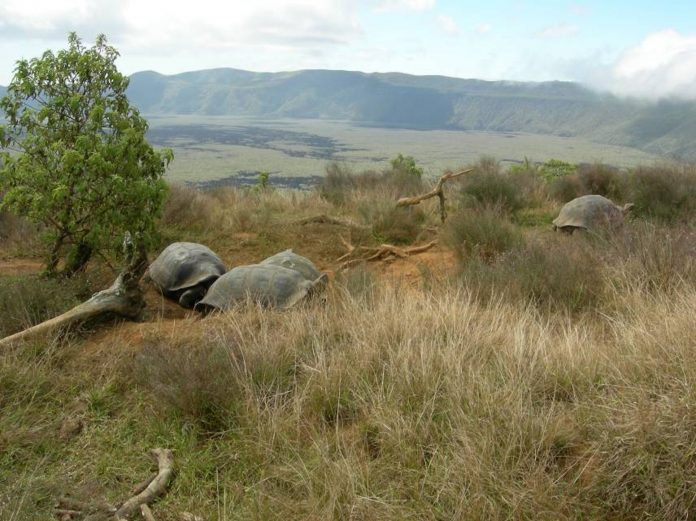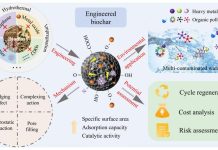Stephen J. Walsh & Carlos F. Mena explain the importance of protecting the Galapagos Islands through interdisciplinary science & sustainable conservation
The Galapagos Islands are facing increasing risk. Globalisation, climate change and international tourism conspire to threaten island sustainability through local and global forces of change. The critical loss of endemic species, wildlife trafficking, and the unrelenting pressure of human impacts have placed these “enchanted islands” in danger. Further, due to their isolation, fragility, and unique organisms, these islands act as an early warning system to recognise the threats to island ecosystems.
Saving the Galapagos Islands requires a dedicated and innovative strategy that is transformative, interdisciplinary, and sustained. The University of North Carolina at Chapel Hill (UNC), U.S. and the Universidad San Francisco de Quito (USFQ), Ecuador, leverage their long-term commitments to the environment, human dimension, and the Galapagos by scaling projects across the sciences to save these islands and, in so doing, create a template for protecting similarly challenged island settings around the globe.
In 2011, the Galapagos Science Center (GSC), San Cristobal Island, Galapagos Archipelago of Ecuador, was dedicated through a strategic partnership between UNC and USFQ. With a focus on population, health and environment, the UNC-USFQ Galapagos Initiative addresses the complex interactions among the social, terrestrial, and marine sub-systems through an interdisciplinary program that fuses research and conservation. Analyses are conducted in the classroom, field/marine, and labs using facilities in the GSC – genetics and microbiology lab, marine ecology lab, terrestrial ecology lab, and spatial analysis and modelling lab. Supported by a staff of 12 professionals, over 100 scientists and a building of 20,000 square feet, the GSC seeks to improve the scientific understanding of human-environment interactions to better inform policies and practices and to encourage wise stewardship.
Grand challenges focus the Galapagos Initiative in resolving critical issues that affect the protection of the Galapagos and their conservation, including: (1) assess island ecosystems and resolve the social-ecological threats to sustainability, (2) foster the health and well-being of people, animals, and ecosystems to better understand their complex interactions, and (3) promote stewardship and extend our knowledge of global environmental change, evolutionary adaptation, and dynamics of local places and global contexts to benefit the Galapagos Islands and beyond.
Research agenda
The problems that we solve are complex, and they cannot be solved by a single scientist working in a narrow field. Solutions require scientists from different disciplines, working together in teams to fuse studies of the environment with studies of people and animal populations, their health and well-being, and their direct and indirect consequences on island sustainability. Several GSC projects showcase the depth and breadth of science and conservation, achieved through a strong partnership with the Galapagos National Park and scientists from collaborative institutions. The projects examine the social, terrestrial, and marine environments through a scientific infrastructure that supports studies at the molecular and landscape scales.
One Health: Integration of human, animal & environmental health
The Galapagos Islands are a living laboratory for One Health research, recognising that the health of humans, animals, and the environment are inextricably linked. Project teams have developed a global alliance of researchers to bring together teams in global health, marine science, nutrition, anthropology, veterinary science, geography, and other disciplines to work synergistically to solve some of the most challenging and complex issues of our time.
Marine microbial ecology in a changing climate
The Galapagos Marine Reserve is facing increasing pressure from tourism and rapid population growth that results in increased fishing and resource harvesting. El Niño events are also occurring more frequently with increased intensity. There is a critical need for an adaptive management plan that incorporates spatial and temporal variability of the marine ecosystem’s structure and health. As the bulk of primary productivity in the Reserve is supported by phytoplankton, projects support the Galapagos National Park’s ecosystem-based management approach by understanding the dependence of primary productivity on physical forcings. Measurements collected through marine cruises that began in 2014 suggest several modes of nutrient delivery, and that plankton community structure and metabolism differentially respond to the nutrient delivery modes as well as marine conditions and El Nino events.
Environmental conservation: Threats from invasive species
One of the greatest threats to the ecosystems of the Galapagos Islands is the growing number, severity, and areal extent of exotic and invasive species. Increased human presence has hastened the introduction of alien species that are now so prevalent that they threaten the native and endemic flora and fauna of the islands and alter ecosystem goods and services. Projects seek to understand the impact of invasive species on iconic species and habitat change. Using high-resolution satellite imagery, combined with farmer surveys, land use maps for the agricultural highlands are generated and validated using unmanned aerial vehicles (drones). Further, ecosystem models are used to assess land suitability for invasive species as a consequence of resource endowments and climate change.
Citizen science & community environmental monitoring
The GSC is participating in an innovative new project called Barcode Galapagos as a way to survey wildlife and plants using “genetic fingerprinting.” GSC, USFQ, and the University of Exeter are cataloguing the archipelago’s famous biodiversity through a citizen science project to document biological life in Galapagos, with all the data generated entirely by local people and processed within the islands. This project provides the scientific knowledge necessary for understanding and conserving key species in the Galapagos. The variety of life in a given area is fundamental to ecosystem stability as well as the services it can provide, including eco-tourism.
Conclusions
Through a focused agenda on human-environment interactions, an interdisciplinary perspective, state-of-the-art facilities and engagement with collaborative partners, the UNC-USFQ Galapagos Initiative is proudly contributing to the health and well-being of the Galapagos Islands through innovative projects that link science and conservation in fundamental ways. Our mission is to conduct studies that contribute to science-informed policy and protect the Galapagos Islands, train students and citizens of the world to better address important questions, engage a diversity of stakeholders and generate new knowledge and innovative practices that contribute to a richer understanding of island ecosystems and threats to their sustainability.
Please note: This is a commercial profile
© 2019. This work is licensed under CC-BY-NC-ND.











